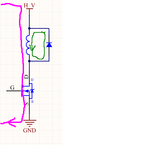xmen_xwk
Full Member level 3
I know what flyback diode does, but how it does and where the extra current goes is kind of confusing.
I have an inductive load to switch from both high and low side. So for this, first I try to switch it at low side. Everyone suggests that a flyback diode parallel to load is good to avoid burning up the switch(mosfet). And it does the job.
But where does the extra voltage go ? In some websites I read the current keep circulate the load until all the current is completely dissipate as heat. If thats true, why current is flowing ? there is no ground. And why it doesn't do that when switch is off in first place ?
In one website, long ago I read, the extra voltage goes back to Power supply. Well in that case, that would destroy the psu ?

I have an inductive load to switch from both high and low side. So for this, first I try to switch it at low side. Everyone suggests that a flyback diode parallel to load is good to avoid burning up the switch(mosfet). And it does the job.
But where does the extra voltage go ? In some websites I read the current keep circulate the load until all the current is completely dissipate as heat. If thats true, why current is flowing ? there is no ground. And why it doesn't do that when switch is off in first place ?
In one website, long ago I read, the extra voltage goes back to Power supply. Well in that case, that would destroy the psu ?

